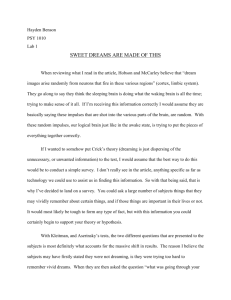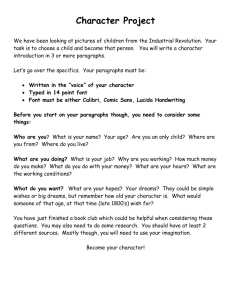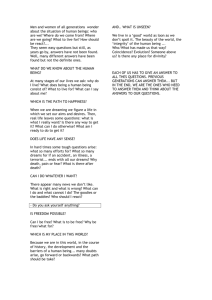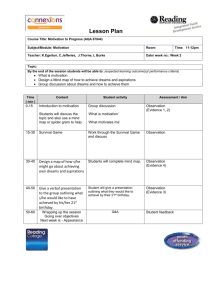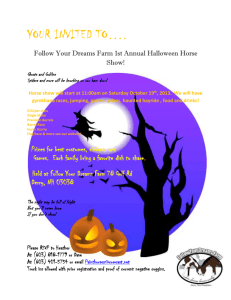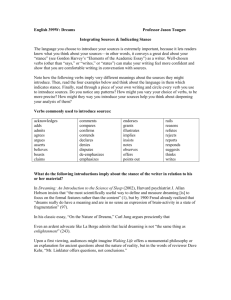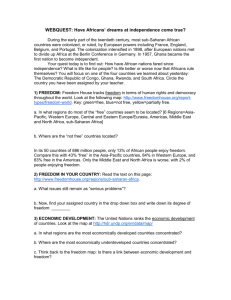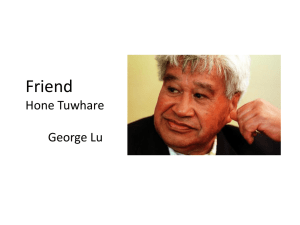Annotated Bibiography
advertisement
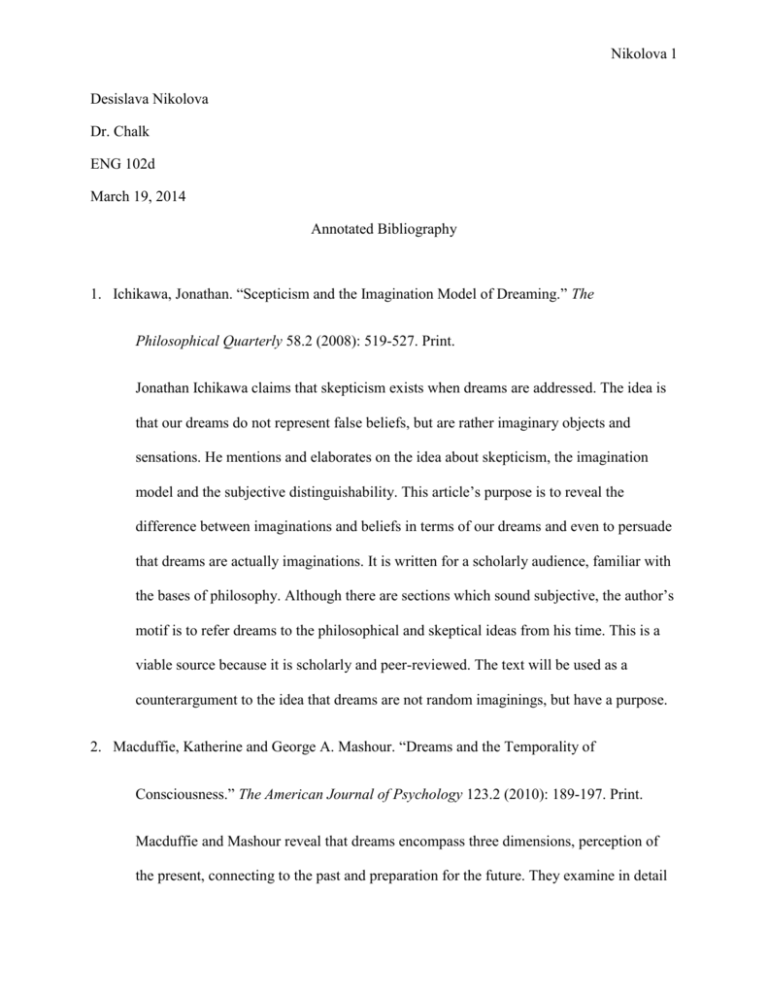
Nikolova 1 Desislava Nikolova Dr. Chalk ENG 102d March 19, 2014 Annotated Bibliography 1. Ichikawa, Jonathan. “Scepticism and the Imagination Model of Dreaming.” The Philosophical Quarterly 58.2 (2008): 519-527. Print. Jonathan Ichikawa claims that skepticism exists when dreams are addressed. The idea is that our dreams do not represent false beliefs, but are rather imaginary objects and sensations. He mentions and elaborates on the idea about skepticism, the imagination model and the subjective distinguishability. This article’s purpose is to reveal the difference between imaginations and beliefs in terms of our dreams and even to persuade that dreams are actually imaginations. It is written for a scholarly audience, familiar with the bases of philosophy. Although there are sections which sound subjective, the author’s motif is to refer dreams to the philosophical and skeptical ideas from his time. This is a viable source because it is scholarly and peer-reviewed. The text will be used as a counterargument to the idea that dreams are not random imaginings, but have a purpose. 2. Macduffie, Katherine and George A. Mashour. “Dreams and the Temporality of Consciousness.” The American Journal of Psychology 123.2 (2010): 189-197. Print. Macduffie and Mashour reveal that dreams encompass three dimensions, perception of the present, connecting to the past and preparation for the future. They examine in detail Nikolova 2 each of these 3 dimensions, connecting them to ideas of Freud. The article also elaborates on the generation of sleep and wakefulness and the differences between REM and NREM. The article’s goal is to teach the three ways dreams apply to real life, the dimensions present, past and future; it is targeted toward the general audience interested in psychology. However, it is reliable because it is peer- reviewed. I will use it to contextualize the practical implications of dreams. 3. Stickhold, Robert. “The Function of Dreaming.” Phi Kappa Phi Forum 93.2 (2013): 1113. Print. Robert Stickhold emphasizes that dreaming has man practical connections. The core of this speculation is that it helps generate information for the dreamer. Stickhold further examines the facts that sleep and dreams solidify our memories, gather the most important information we have perceived during the day, and organize the information already gathered by our brains. This article is for the general audience and its goal is to teach general knowledge about dreams and sleep and how they affect our perception of information. It does not have a solid motif because it’s purpose is to objectively ilustrate, but still it is reliable because it is peer-reviewed. 4. Mullane, Harvey. “Defense, Dreams and Rationality.” Synthese 57.2 (1983): 187-203. Print. Mullane argues that dreams are viewed as means of unconscious defense. They are products of the ego, which help people reflect on ideas and memories they need a defense from. This main point is revealed through the discussion of ideas such as dreams and Nikolova 3 their power to reveal symptoms and to prove some disruptions in people’s minds. The author also elaborates on Freud’s lectures, the “insentient forces”, and reflexes. This article’s goal is to teach the reader the interconnection between unconscious defense and dreams, arguing that dreams themselves are a form of self-defense and part of the unconscious mind. It is targeted toward the scholarly audience interested in Psychological and Philosophical texts, such as Freud’s. Its motif is to prove that Freud’s theories are applicable, meaning that dreams should be connected towards the unconscious aspect of the mind. Thus the article could have some bias, meaning that the author could subjectively express his favor for Freud. Another minor issue is that the article is not very recent, but it is published in the 1980s. However, it is scholarly, peerreviewed and reliable, and I plan to use it as a counterargument to the current theories that dreams are actually a product of the conscious mind. 5. Sosa, Ernest. “Dreams and Philosophy.” Proceedings and Addresses of the American Philosophical Association 79.2 (2005): 7-18. Print. Ernest Sosa shares a contemporary view that when dreaming one does not believe the subject of the dream, but only imagines it; this is an idea shared by many philosophers. The author illustrates this point by pointing out that we surely do not believe the states we come to be in while dreaming, such as being a robber, because if we really did, we would be accused of crime and robbery, which is not the case. Sosa also discusses Descartes’ skepticism, some facts from the science of sleep and dreaming and the Imagination model. The goal of the article is to persuade the reader that imagination lies beneath dreaming and that indivisuals actually do not believe their dreams; it gives many Nikolova 4 examples to prove this point. The text is written for the general audience. Sosa’s motif is to deny wrong assumptions about dreaming, but without being too subjective and judgmental. The article is published by the Brown University Press and it is perreviewed, so it’s definitely a viable source. My intention is to use this article so that I contextualize the idea about skepticism and the imagination model of dreaming. 6. Valli, Katja. “Dreams are more negative than real life: Implications for the function of dreaming.” Cognition and Emotion 22.5 (2008): 833-861. Print. Valli, Strandholm, etc. claim that emotions from the real life are in a close relationship with dreaming. The negative emotions in dreaming are much more powerful than those from real life. The authors address these issues by discussing various proposed ideas, such as the one about the dominance of negative emotions in the brain, the recreational function of dreaming, and dreams’ function to prepare us for the distressing occurrences in our waking sage. The article is written for the general audience, and its goal is to teach and illustrate some of the practical functions of dreaming, which are connected to emotions from the waking stage. Its motif is to convince that there is practicality in dreams that most people forget about. The article is viable because it is peer-reviewed and my intention is to use it to contextualize the functions of dreaming and as specific, detailed information, since the text itself is a broad study with hypotheses, analysis and conclusion. 7. Schredl, Michel and Daniel Erlacher. “Self-Reported Effects of Dreams on Waking-Life Creativity: An Empirical Study.” Journal of Psychology 141.1 (2007): 35-46. Print. Nikolova 5 Michel Schredl and Daniel Erlacher describe a study for observation of the creativity of people and whether their dreams had any correlation with the development of their creativity. It turns out that there is a strong link. There are dreams which stimulate people’s creativity, and this occurrence has a considerable impact on people’s lives. The study makes this generalization through the investigation of the ways dreams have effects on creativity, such as involvement of images in the creative work of an individual, the lessons dreams sometimes teach and the problems they solve, and the emotional insights they pose. This article is written for the general audience, and its goal is to reveal the correlation between creativity and dreams. It does not have any motif, but it is reliable because it is scholarly and peer-reviewed. I intend to use it to contextualize the functions of dreams and to provide specific and detailed information, for example the results of the study, presented in the article. 8. Flanagan, Owen. Dreaming Souls: Sleep, Dreams, and the Evolution of the Conscious Mind. Cary: Oxford UP, 2001. Ebsco Host. Web. 18 March 2014. Owen Flanagan shares his personal beliefs that sleep in general many biological functions for the body; however, according to him dreams have no biological function. The author elaborates on this point using ideas about the absence of wish-fulfillment in dreams, the importance of dreams and their usefulness. The book is for audience, interested in dream interpretation and the philosophy of the mind. Its goal is to shed some light on the subject of the actual function of dreams. Possibly the motif of the author is to reject Freud’s conclusions and to set forth his own; thus the book indeed has some sections, where the evaluations are rather subjective. However, it is a reliable source because it is peer- Nikolova 6 reviewed and is issued by the Oxford University Press. I intend to use it to contextualize the topic about functions of dreams. 9. Kahn, David and J. Allan Hobson. “Self-organization and the Dreaming Brain.” Harvard Mental Health Letter 10.11 (1994): 1-3. Ebsco Host. Web. 21 Mar. 2007. David Kahn and Allan Hobson discuss the process of organization in the brain, the role dreams play in this organization and the way dreams themselves are created. The authors reveal these processes by first introducing the ideas about chaos and organization, then by addressing these to dreams and then by discussing the activities of the brain during sleep. The article is for educated audience in the fields of biology and psychology. Its goal is to reveal the way dreams are created, but does not have a motif, as it is very descriptive. It is relevant and viable because it is scholarly and peer-reviewed. My intention is to use the article as aggregate information about how the dream arises in the brain. Another option is not preferable because the article is loaded with technical terms. Nikolova 7
